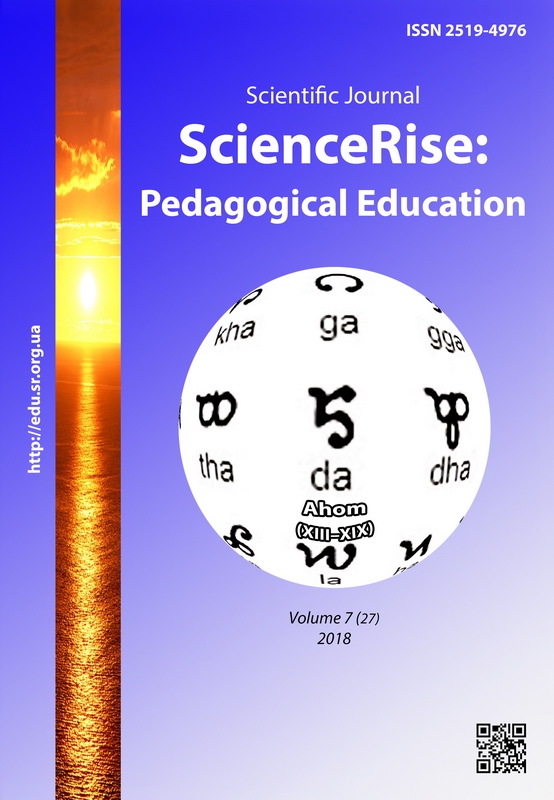Online tools of visualization in the work of the modern teacher
DOI:
https://doi.org/10.15587/2519-4984.2018.151557Keywords:
visualization tools, pedagogical online tools, the classification of online tools, didactic meansAbstract
Cloud technologies opened up an access to a variety of powerful multifunctional visualization software for various purposes, the use of which allows solving the problems of intensification and humanization of the educational process, its adaptation to the needs and cognitive features of the younger generation, improving the quality and effectiveness of training and many others. However, the introduction of this tool into a broad educational practice needs the support of teachers in mastering the space of new opportunities. The aim of the article is to develop such a classification of online visualization tools for educational information, which would serve as a reliable guide in choosing an effective tool for solving a particular pedagogical task. The presented classification covers more than 200 modern online tools for creating visual materials. The tools are selected according to their effectiveness, functional ability and efficiency of use in pedagogical activity. Six categories of these instruments are identified according to the nature of the pedagogical tasks for which they are applied: tools for creating visual support for the presentation of educational material; tools for the compression, systematization and structuring of educational material; tools for creating didactic games; tools for modeling; tools for creating a joint activity area for students and teachers; tools for the implementation of operational feedback. Within the specified categories, the tools are grouped according to the types of the final product, a didactic tool developed using visualization technologies. In general, we are talking about 34 types of such funds. A brief general description of the functionality of each of the tool groups and a list of services for creating the corresponding didactic means are given
References
- Stupnyckyi, O., Solyanyk, S. (2017). Development of cloud technologies of modern network-information economy. Actual problems of international relations, 133, 106–116.
- Eppler, M. J., Lengler, R. (2007). Towards a periodic table of visualization methods. Proceeding GVE '07 Proceedings of the IASTED International Conference on Graphics and Visualization in Engineering. Clearwater, 83–88.
- Shilova, O. (2012). Summary table of Internet services – ICT tools for teaching and learning activities. Available at: https://docs.google.com/document/d/1a3XZUsdGTymfZeVH5sYAmLkZdfIrwRSsvBji6YNCrxc/edit Last accessed: 04.05.2018
- Useful services for creating presentations and visualization of information. Navchalnyi portal NUBIP. Available at: http://elearn.nubip.edu.ua/pluginfile.php/259625/mod_resource/content/1/211876.pdf Last accessed: 04.05.2018
- Useful services and teacher’s tools. Portal Etwinning Plus. Available at: http://etwinning.com.ua/content/files/739191.pdf Last accessed: 04.05.2018
- Korduba, L. (2015). The nine best services for creating presentations. Available at: http://igrovicainformatik.blogspot.com/2015/01/9.html Last accessed: 04.05.2018
- Bekuzarova, N., Ermolovich, E., Tkacheva, A. (2015). Analytical review of infographic services. Sovremennye problemy nauki i obrazovaniia, 6. Available at: http://www.science-education.ru/ru/article/view?id=23256 Last accessed: 04.05.2018
- The five online services for poll of students. Osvitoriya Media. Available at: https://osvitoria.media/experience/5-onlajn-servisiv-shho-dopomozhut-vchytelyu-myttyevo-opytaty-uves-klas Last accessed: 04.05.2018
- Gavrilova, T., Guliakina, N. (2008). Visual methods of working with knowledge: an attempt to review, Iskusstvennyi intellekt i priniatie reshenii, 1, 15–21.
- Machlis, Sh. (2016). Chart and image gallery: 30+ free tools for data visualization and analysis. Computerworld. Available at: http://www.computerworld.com/article/2506820/businessintelligence/business-intelligence-chart-and-image-gallery30-free-tools-for-data-visualization-and-analysis.html Last accessed: 04.05.2018
- Sysoeva, Yu. (2016). Computerized Data Visualization Tools. Information processing systems, 4, 233–235. Available at: http://nbuv.gov.ua/UJRN/soi_2016_4_46 Last accessed: 04.05.2018
- Rathore, M. K., Sonawat, R. (2015). Integration of technology in education and its impact on learning of students. Internaltional Journal of Applied Home Science, 2 (7-8), 235–246.
Downloads
Published
How to Cite
Issue
Section
License
Copyright (c) 2018 Lyudmyla Bilousova, Natalya Zhytyenyova

This work is licensed under a Creative Commons Attribution 4.0 International License.
Our journal abides by the Creative Commons CC BY copyright rights and permissions for open access journals.
Authors, who are published in this journal, agree to the following conditions:
1. The authors reserve the right to authorship of the work and pass the first publication right of this work to the journal under the terms of a Creative Commons CC BY, which allows others to freely distribute the published research with the obligatory reference to the authors of the original work and the first publication of the work in this journal.
2. The authors have the right to conclude separate supplement agreements that relate to non-exclusive work distribution in the form in which it has been published by the journal (for example, to upload the work to the online storage of the journal or publish it as part of a monograph), provided that the reference to the first publication of the work in this journal is included.








